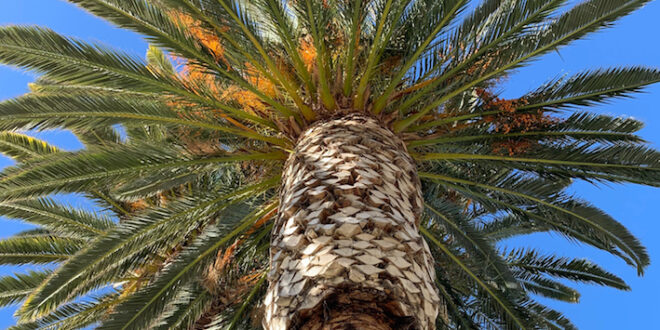Stately, elegant, and even iconic, Phoenix Palms have inveigled their way into our gardens, and our history. Unfortunately, their reputation as a highly dangerous plant, and the cause of many injuries (some of them very serious) is less well known.
The Phoenix Palm (Phoenix canariensis), is a species of palm native to the Canary Islands and other regions of Northern Africa. Tall (they can grow up to 15 meters high), and with lush, feathery fronds that lend a tropical air to any site, the Phoenix Palm thrives in warm, subtropical climates. However, it will also happily grow in cooler climes, and in a wide range of soil types. All of which has seen it become highly prized in New Zealand as a landscaping tree, as well as (when young), a container-grown, plant.
The Phoenix Palm was once so enjoyed, in 1922 it was chosen for an official street planting in Raglan, to mark the visit to the town of the then Governor-General, Viscount Jellicoe. Raglan’s well known trees are now in their 101st year, and are regarded as an historic landmark. So, given the Phoenix Palm’s many attributes, why are these majestic palms of concern? As it turns out, they can be highly dangerous.
Over the last few years, in New Zealand alone, there have been well in excess of 500 injuries a year from Phoenix Palms. And these have cost the country hundreds of thousands of dollars. Middlemore Hospital has reported Phoenix Palm injuries have, at times, accounted for 50 of the hand surgeries it has conducted, annually. The reason behind these alarming figures is the vicious spikes on the Phoenix Palm’s new growth.
As a natural defense against predators, the new growth of the palm is covered in tiny, needle-like structures known as raphides. These ‘needles’ harbour a toxic compound called calcium oxalate. When an unwary gardener (or a child playing near a palm) comes into contact with the raphides, the needles pierce the skin, and the calcium oxalate crystals are released.
Inside the body, calcium oxalate can cause severe pain, swelling, irritation, and inflammation. Symptoms such as burning, itching, and redness can occur rapidly, and if a sufferer is especially sensitive, allergic reactions can result in breathing problems, anaphylaxis, or other serious health consequences. Immediate medical attention is paramount, and if left untreated, it has even been reported amputation has been required.
You may well ask, given the stature of the Phoenix Palm, how anyone, especially a child, could come into contact with the new growth of this tree’s fronds. But the worrying fact is Phoenix Palms are often grown in containers. This means young growth is easily within reach. As well as this, Phoenix Palms (now considered a noxious plant in parts of New Zealand) are well known for self-seeding. This means young palms can be readily accessed.
If you have a Phoenix Palm growing on your property, and wish it wasn’t, don’t entertain handling the removal job yourself. Not only is there a danger of encountering the toxic spines, but machinery used in doing the job can also suffer. This is due to the sap from the palm being highly corrosive, and completely capable of destroying the likes of a chainsaw. The fibrous palms are also heavy, and pose a danger should they fall in an uncontrolled way. Then there is the difficult and potentially dangerous task of disposing of the debris. Better, by far, to call in the experts.
Shockingly, Phoenix Palms can still be found growing in parks, school grounds, and in or close to playgrounds. And some outlets still sell them! As for what you can do to protect yourself and others from the dangers of the Phoenix Palm, educate yourself so you can recognise these trees, especially in their juvenile form, and let relevant commercial outlets and authorities know of your concerns.
Should you, or anyone you know, be injured by a Phoenix Palm, seek medical attention immediately.










Join the Discussion
Type out your comment here:
You must be logged in to post a comment.